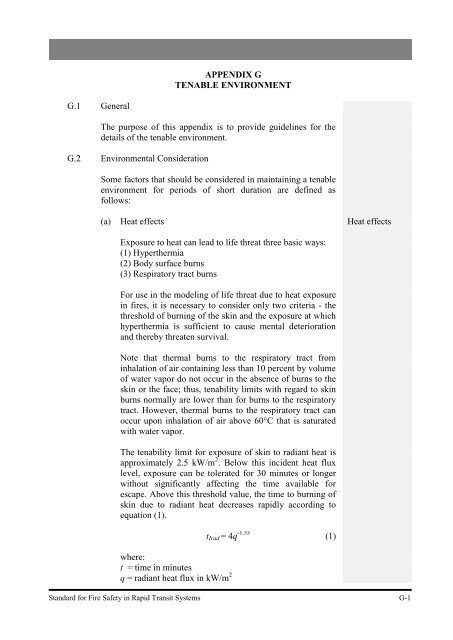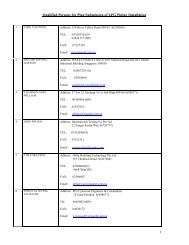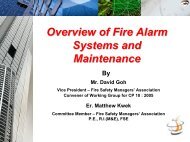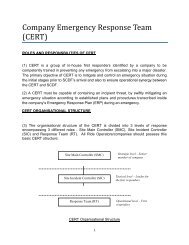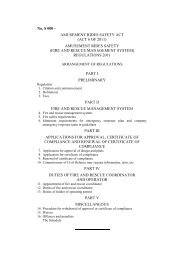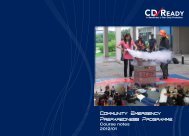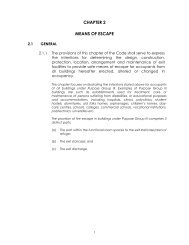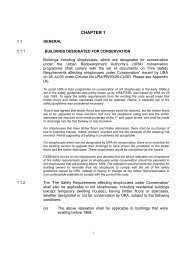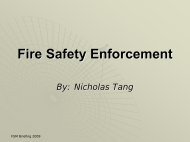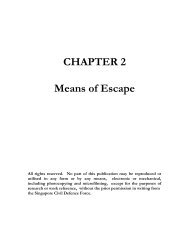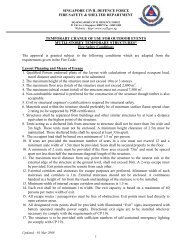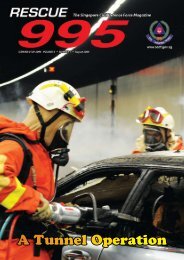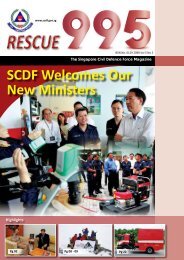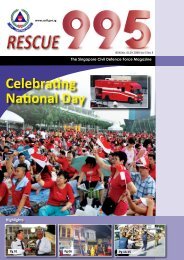Standard for Fire Safety in Rapid Transit Systems - Singapore Civil ...
Standard for Fire Safety in Rapid Transit Systems - Singapore Civil ...
Standard for Fire Safety in Rapid Transit Systems - Singapore Civil ...
Create successful ePaper yourself
Turn your PDF publications into a flip-book with our unique Google optimized e-Paper software.
G.1 General<br />
APPENDIX G<br />
TENABLE ENVIRONMENT<br />
The purpose of this appendix is to provide guidel<strong>in</strong>es <strong>for</strong> the<br />
details of the tenable environment.<br />
G.2 Environmental Consideration<br />
Some factors that should be considered <strong>in</strong> ma<strong>in</strong>ta<strong>in</strong><strong>in</strong>g a tenable<br />
environment <strong>for</strong> periods of short duration are def<strong>in</strong>ed as<br />
follows:<br />
(a) Heat effects<br />
Exposure to heat can lead to life threat three basic ways:<br />
(1) Hyperthermia<br />
(2) Body surface burns<br />
(3) Respiratory tract burns<br />
For use <strong>in</strong> the model<strong>in</strong>g of life threat due to heat exposure<br />
<strong>in</strong> fires, it is necessary to consider only two criteria - the<br />
threshold of burn<strong>in</strong>g of the sk<strong>in</strong> and the exposure at which<br />
hyperthermia is sufficient to cause mental deterioration<br />
and thereby threaten survival.<br />
Note that thermal burns to the respiratory tract from<br />
<strong>in</strong>halation of air conta<strong>in</strong><strong>in</strong>g less than 10 percent by volume<br />
of water vapor do not occur <strong>in</strong> the absence of burns to the<br />
sk<strong>in</strong> or the face; thus, tenability limits with regard to sk<strong>in</strong><br />
burns normally are lower than <strong>for</strong> burns to the respiratory<br />
tract. However, thermal burns to the respiratory tract can<br />
occur upon <strong>in</strong>halation of air above 60°C that is saturated<br />
with water vapor.<br />
The tenability limit <strong>for</strong> exposure of sk<strong>in</strong> to radiant heat is<br />
approximately 2.5 kW/m 2 . Below this <strong>in</strong>cident heat flux<br />
level, exposure can be tolerated <strong>for</strong> 30 m<strong>in</strong>utes or longer<br />
without significantly affect<strong>in</strong>g the time available <strong>for</strong><br />
escape. Above this threshold value, the time to burn<strong>in</strong>g of<br />
sk<strong>in</strong> due to radiant heat decreases rapidly accord<strong>in</strong>g to<br />
equation (1).<br />
where:<br />
t = time <strong>in</strong> m<strong>in</strong>utes<br />
q = radiant heat flux <strong>in</strong> kW/m 2<br />
tIrad = 4q -1.35 (1)<br />
Heat effects<br />
<strong>Standard</strong> <strong>for</strong> <strong>Fire</strong> <strong>Safety</strong> <strong>in</strong> <strong>Rapid</strong> <strong>Transit</strong> <strong>Systems</strong> G-1


